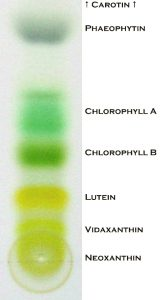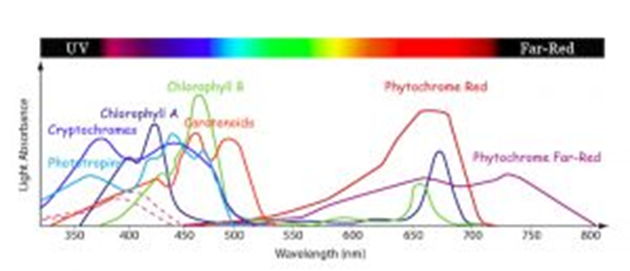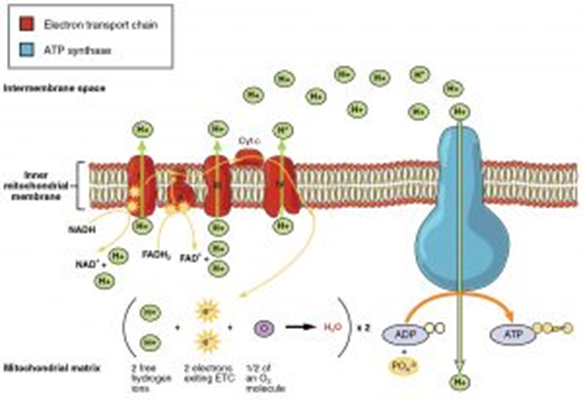Contents
Energy for Biological Processes
Photosynthesis
Chlorophyll is located in the photosystems on the thylakoid membrane and is a mixture of colored proteins that can absorb light. There are 5 key closely related pigments, but chlorophyll a is the most abundant.
Below are the 5 pigments and the color they appear:
- Chlorophyll a = blue/green (found in all plants)
- Chlorophyll b = yellow/green
- Carotene = orange
- Xanthophyll = yellow
- Phaeophytin = grey
There are different proportions of each pigment in leaves, which gives leaves slightly different colors.
As each pigment absorbs a different wavelength of visible light, this maximizes the spectrum of visible light that the plant can absorb, and therefore increases the amount of light energy absorbed.
The pigments in chlorophyll can be isolated using chromatography.
The pigments are added to chromatography paper which is placed in a solvent. The solvent dissolves the pigments, and the more soluble the pigment the further up the chromatography paper it will move. This can be converted into an Rf value, a way to then compare and identify pigments in chromatography, using the formula below.
Rf value = Distance moved by pigment from origin to center of pigment spot / Distance from origin to solvent front
Light Dependent Reaction (LDR)
NADPH which can then be used in the light-independent stage.
This occurs in three key stages:
- Photolysis. This is when light energy is absorbed by chlorophyll in photosystem II and splits water into oxygen, H+ and e-. The H+ is picked up by NADP to form NADPH and used in the LIR. The e- are passed along a chain of electron carrier proteins. The oxygen is either used for respiration or diffuses out of the leaf through the stomata.
- Photoionization of chlorophyll. This is when light energy is absorbed by the chlorophyll and the energy results in electrons becoming excited and raising up an energy level to leave chlorophyll. Therefore, the chlorophyll has been ionized by light.
Chemiosmosis
The electrons that gained energy and left the chlorophyll move along a series of proteins embedded within the thylakoid membrane. As they move along they release energy and some of the energy from electrons is used to pump the protons from photolysis across chloroplast membranes. The protons pass through the enzyme ATP synthase, which results in the production of ATP. The protons combine with the co-enzyme NADP to become NADPH. Because the protons move from a high to low concentration gradient this is known as chemiosmosis.
Light-Independent Reaction (LIR)
The light-independent reaction is a cycle, the Calvin cycle. It uses carbon dioxide, reduced NADP and ATP to form a hexose sugar. The ATP is hydrolyzed to provide energy for this reaction and the NADPH donates the hydrogen to reduce molecules GP in the cycle.
The Calvin cycle occurs in the stroma, and this fluid contains the enzyme RuBisco which catalyzes this reaction. This stage is temperature sensitive due to the fact it involves an enzyme.
Respiration
Respiration is the reaction that produces the ATP needed for other metabolic reactions in cells. It is an enzyme-controlled reaction and is therefore sensitive to temperature and pH changes.
Glucose is broken down to release the ATP, but if there is no glucose, glycogen (in animals) or starch (in plants) stores of glucose left then other respiratory substrates are used. Lipids can be hydrolyzed to glycerol and fatty acids. The glycerol is then phosphorylated into triose phosphate and enters aerobic respiration at the Krebs cycle. Proteins could also be modified and used. Amino acids must be hydrolyzed and the amino group removed (deamination). The carbon compound that remains can enter the Krebs cycle.
Aerobic Respiration
Aerobic respiration is split into four stages:
- Glycolysis (cytoplasm)
- Link reaction (Mitochondrial matrix)
- Krebs cycle (Mitochondrial matrix)
- Oxidative Phosphorylation (Cristae)
In this stage, all the accumulated reduced coenzymes release the hydrogens and these split into protons (H+) and electrons (e-). The e- are passed down a series of electron carrier proteins embedded in the inner mitochondrial membrane, losing energy as they move (electron transport chain). The small amount of energy the electrons release pumps protons from the mitochondrial matrix into the intermembrane space. This creates an electrochemical gradient across the membrane. Therefore, the protons move down the electrochemical gradient back into the matrix via ATP synthase, making ATP. This movement of H+ is known as chemiosmosis. Oxygen is the final electron acceptor in the electron transport chain. The oxygen combines with the electrons and the protons to form water.
Glycolysis
Glycolysis is the first stage and as it does not require oxygen and occurs in the cytoplasm it is in both anaerobic and aerobic respiration.
Glycolysis (sugar splitting) involves three key stages:
- Substrate level phosphorylation - The glucose has two phosphate groups added to it from two ATP molecules.
- Phosphorylation makes the glucose-2-phosphate unstable and it splits into two 3-carbon compounds, triose phosphate (TP).
- The two TP molecules are both oxidized to form two pyruvate molecules by removing a hydrogen from each. The hydrogen is picked up by two NAD molecules to become NADH. This process also releases 4 ATP.
Therefore, glycolysis results in the production of 2 NADH, 2 pyruvate, and a net gain of 2 ATP.
The NADH and pyruvate are both needed for subsequent stages in aerobic respiration and therefore are actively transported into the mitochondrial matrix.
Link Reaction
This reaction occurs in the mitochondrial matrix and converts pyruvate into acetyl CoA.
Pyruvate contains 3 carbons whereas acetyl CoA contains two, so a carbon is removed in this stage in the form of carbon dioxide. This is known as decarboxylation and requires decarboxylase enzymes. 2 hydrogen atoms are also removed to oxidize the carbon compound further to create acetate. This is known as dehydrogenation and is catalyzed by dehydrogenase enzymes. The NAD picks up the hydrogen to become NADH. The coenzyme CoA combines with the acetate that is formed to create acetyl CoA, this is to assist in acetyl reacting in the Krebs cycle.
The reaction occurs twice per glucose molecule as there are two pyruvate molecules.
The overall products from the link reaction per glucose molecule are:
- 2 x Acetyl CoA
- 2 CO2
- 2 reduced NAD
Krebs Cycle
The acetyl CoA reacts with a four-carbon molecule, releasing coenzyme A and producing a six-carbon molecule that enters the Krebs cycle. In a series of oxidation-reduction reactions, the Krebs cycle generates 8 reduced coenzymes, 2 ATP by substrate-level phosphorylation, and 4 carbon dioxide is lost.
In total, therefore, per glucose molecule, 2 ATP, 6 NADH, and 2 FADH are produced. The Krebs cycle is also known as the citric acid cycle.
Oxidative Phosphorylation
This is the final stage of aerobic respiration where most ATP is synthesized, and oxygen is used. This stage involves the transfer of electrons down the electron transfer chain and the movement of protons across the inner mitochondrial membranes. The movement of these protons is down a concentration gradient catalyzed by ATP synthase, embedded in these membranes- this is another example of the chemiosmotic theory.
Anaerobic Respiration
In the absence of oxygen, respiration occurs anaerobically. The pyruvate produced in glycolysis is reduced to form ethanol (in plants and microbes) or lactate (in animals) by gaining the hydrogen from reduced NAD. This oxidizes NAD so that it can be reused in glycolysis and ensures more ATP is continued to be produced.
Efficiency
1 reduced NAD can result in a yield of 3 ATP molecules, whereas 1 reduced FAD can result in a yield of 2 ATP molecules. Therefore, the total yield of ATP from one glucose molecule should be 38 molecules of ATP. Aerobic respiration is approximately 32% efficient. This is due to some protons leaking across the mitochondrial membrane during oxidative phosphorylation, ATP being used to actively transport pyruvate and NADH into the matrix, and because some energy is lost as heat.
Anaerobic respiration is even less efficient because only 2 ATP molecules are produced from one glucose molecule.
Different respiratory substrates have relatively different energy values. Carbohydrates are the first respiratory substrate used within organisms, but if there are none left, lipids and proteins can be converted to substrates to use.
The respiratory quotient of each substrate can be calculated using the formula:
RQ = CO2 produced / O2 consumed
- What is the role of the pigments in plants?
- Your answer should include: Absorb / Light / Energy
- What are the two sets of reactions in photosynthesis?
- Your answer should include: Light / Dependent / Independent
- Where does the LDR occur?
- Your answer should include: Thylakoid / Membrane / Grana / Granum
- What is photolysis?
- Your answer should include: Splitting / Water / Light / Energy
- What is photoionization?
- Your answer should include: Electrons / Chlorophyll / Excitation
- What is chemiosmosis?
- Your answer should include: H+ / Movement / ATP / Synthase
- Why is NADPH needed from the light-dependent stage?
- Your answer should include: Reduce / GP / TP
- How many carbons does glucose have?
- Your answer should include: 6 / six
- Where does glycolysis take place?
- Cytoplasm
- Why are the glycolysis reactions described as anaerobic?
- Oxygen
- Where does the Krebs cycle take place?
- Your answer should include: Mitochondrial / Matrix
- How many carbons does the intermediate that reacts with acetyl CoA have?
- Your answer should include: 4 / four
- How many carbon dioxides are lost per turn of the Krebs cycle?
- Your answer should include: 2 / two
- What is the final electron and hydrogen acceptor in oxidative phosphorylation?
- Oxygen












